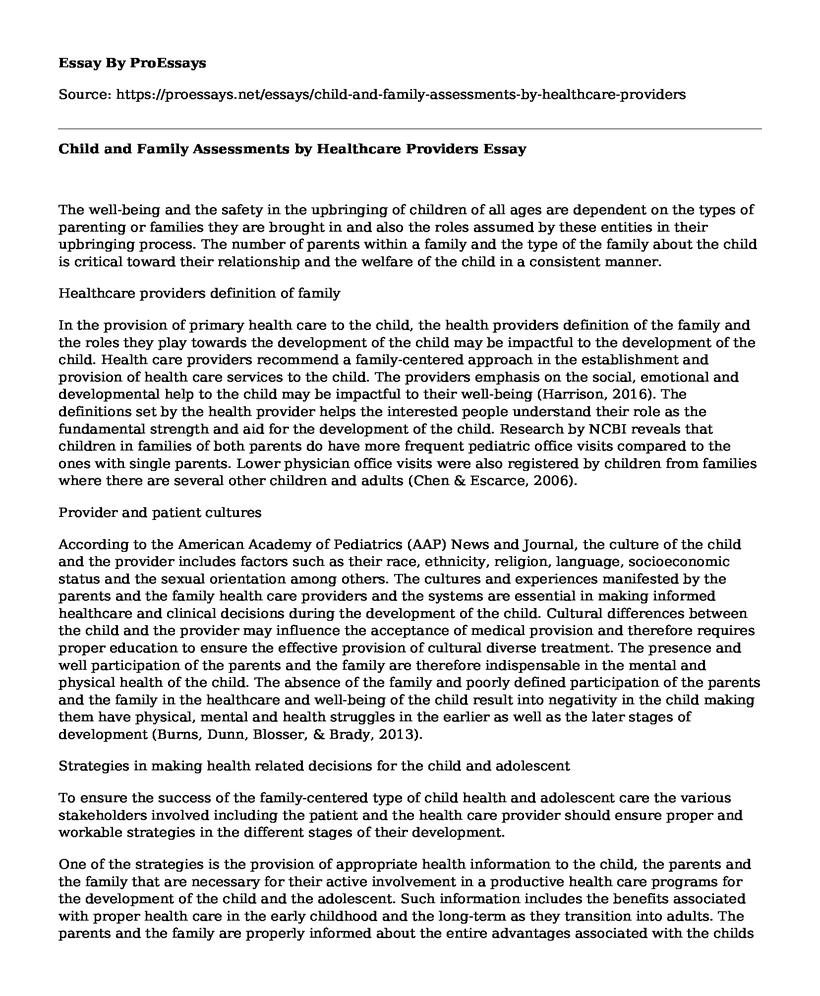The well-being and the safety in the upbringing of children of all ages are dependent on the types of parenting or families they are brought in and also the roles assumed by these entities in their upbringing process. The number of parents within a family and the type of the family about the child is critical toward their relationship and the welfare of the child in a consistent manner.
Healthcare providers definition of family
In the provision of primary health care to the child, the health providers definition of the family and the roles they play towards the development of the child may be impactful to the development of the child. Health care providers recommend a family-centered approach in the establishment and provision of health care services to the child. The providers emphasis on the social, emotional and developmental help to the child may be impactful to their well-being (Harrison, 2016). The definitions set by the health provider helps the interested people understand their role as the fundamental strength and aid for the development of the child. Research by NCBI reveals that children in families of both parents do have more frequent pediatric office visits compared to the ones with single parents. Lower physician office visits were also registered by children from families where there are several other children and adults (Chen & Escarce, 2006).
Provider and patient cultures
According to the American Academy of Pediatrics (AAP) News and Journal, the culture of the child and the provider includes factors such as their race, ethnicity, religion, language, socioeconomic status and the sexual orientation among others. The cultures and experiences manifested by the parents and the family health care providers and the systems are essential in making informed healthcare and clinical decisions during the development of the child. Cultural differences between the child and the provider may influence the acceptance of medical provision and therefore requires proper education to ensure the effective provision of cultural diverse treatment. The presence and well participation of the parents and the family are therefore indispensable in the mental and physical health of the child. The absence of the family and poorly defined participation of the parents and the family in the healthcare and well-being of the child result into negativity in the child making them have physical, mental and health struggles in the earlier as well as the later stages of development (Burns, Dunn, Blosser, & Brady, 2013).
Strategies in making health related decisions for the child and adolescent
To ensure the success of the family-centered type of child health and adolescent care the various stakeholders involved including the patient and the health care provider should ensure proper and workable strategies in the different stages of their development.
One of the strategies is the provision of appropriate health information to the child, the parents and the family that are necessary for their active involvement in a productive health care programs for the development of the child and the adolescent. Such information includes the benefits associated with proper health care in the early childhood and the long-term as they transition into adults. The parents and the family are properly informed about the entire advantages associated with the childs proper development and how they affect the general family.
Second, the health provider and the parent should decide when to disclose valuable information and involve the child or adolescent in decision-making about their health and well-being (Holt, 2011). The type of healthcare information they are exposed to should be regulated for various stages of development.
Finally, the ability and desire of some children and adolescents to make their decisions in some aspects of health care should be carefully evaluated and considered when providing the family-centered health care. The decisions they want to make should be handled appropriately by the parents and the family members.
Change of strategies with different developmental stages
The recommended above may vary depending on the stage of development of the child or the adolescent. For instance, some children may be too young to have their health care decisions considered as resolute and workable. The information provided to these children also varies depending on their developmental stages and level. If allowed to make decisions, their decisions should also be handled differently based on the stage of development as well.
Burns, C., Dunn, A., Blosser, C., & Brady, M. (2013). Pedriatic Primary Care (5th ed). Philadelphia: Elsevier.
Harrison, C. (2016). Treatment decisions regarding infants, children and adolescents. PubMed Central (PMC). Retrieved 27 November 2016, from https://www.ncbi.nlm.nih.gov/pmc/articles/PMC2720471/
Holt, K. (2011). Bright futures (1st ed., pp. 13-37). Elk Grove Village: American Academy of Pediatrics.
Ensuring Culturally Effective Pediatric Care: Implications for Education and Health Policy. (2004). AAP News and Journals. Retrieved 29 November 2016, from http://pediatrics.aappublications.org/content/114/6/1677
Chen, A. & Escarce, J. (2006). Effects of Family Structure on Children's Use of Ambulatory Visits and Prescription Medications. Health Services Research, 41(5). http://dx.doi.org/10.1111%2Fj.1475-6773.2006.00584.x
Cite this page
Child and Family Assessments by Healthcare Providers. (2021, Mar 29). Retrieved from https://proessays.net/essays/child-and-family-assessments-by-healthcare-providers
If you are the original author of this essay and no longer wish to have it published on the ProEssays website, please click below to request its removal:
- Tobacco as a Health Issue Essay
- The Scale of America's Opioid Epidemic Is Shocking
- The LGBT Population and HIV/AIDS Infection Paper Example
- Reed Healthcare System and CHNA Paper Example
- Nursing and Surgery - Questions and Answers Essay
- Essay Example on Social Activism: Taking Action for Essential Causes in Society
- Evidence-Based Practice for Type 2 Diabetes Care - Research Paper







